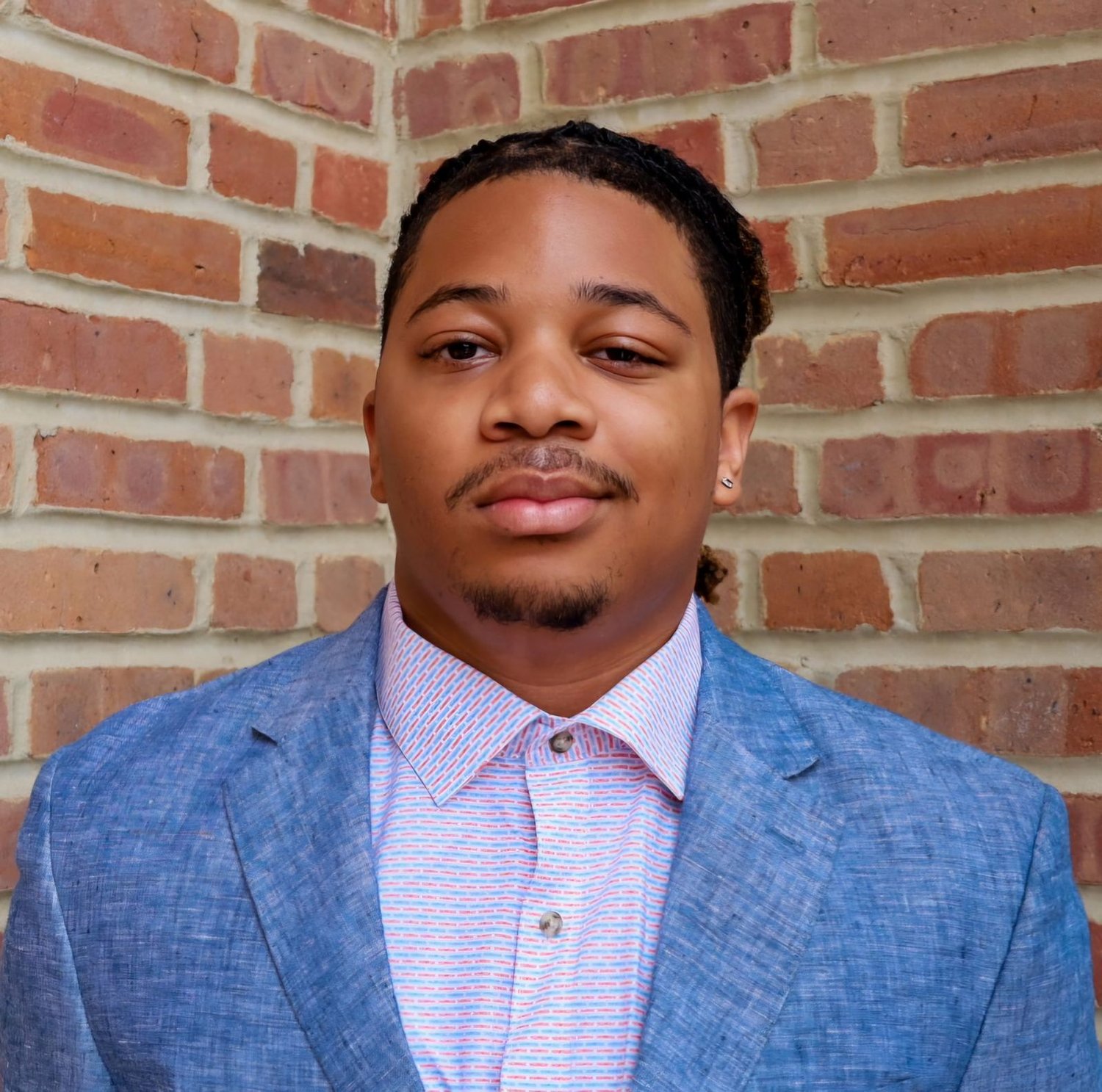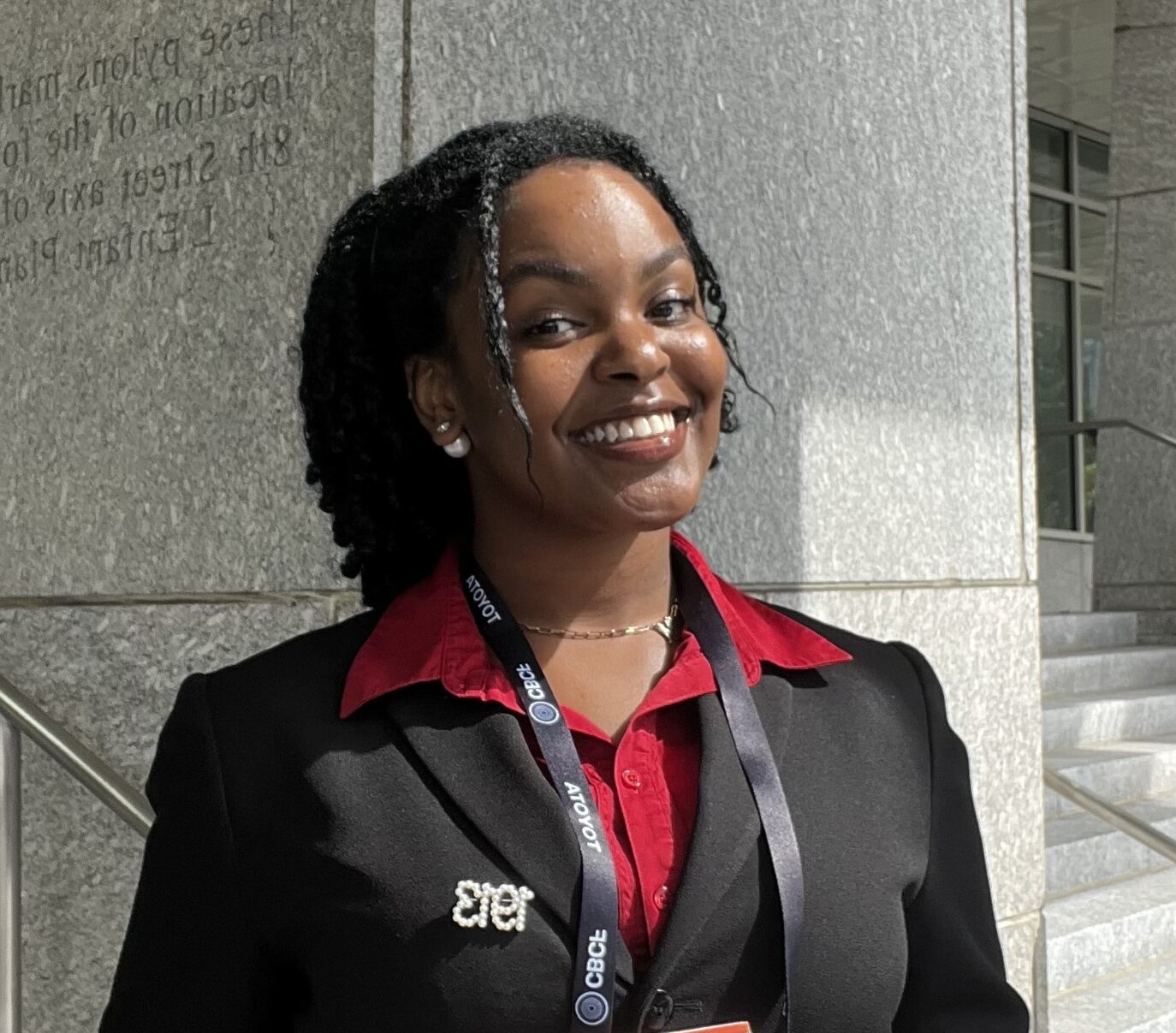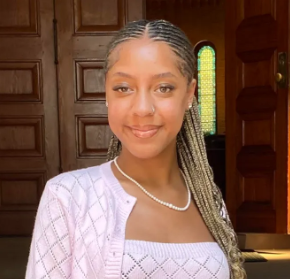Student Showcase
WHOV-TV package on World Wildlife Fund Environmental Journalism scholarship. Interviews with Charles Sumpter, Senior Director, People and Culture, WWF; Jessica Leung, Director of People and Culture, WWF; HoneyRose Smith, second-year journalism major and Environmental Journalism scholarship recipient.
Senior Portfolios
Click the student’s photo to view their portfolio.
Fall 2024 Stories
HAMPTON— Kyndall Hawkins, a student at Hampton University, balances her studies with her hair business. She serves three to four clients weekly and operates out of her dorm lobby in Winona Hall, where she has created a space for clients.
But right before Homecoming, as she prepared for a client, her dorm director, Iris-Goode Middleton, received sudden news: dorm visitation was immediately banned, and she could no longer conduct her business there.
“You can use the laundry room,” Middleton told her, Hawkins said, offering the small room with 4 machines, but Hawkins had to cancel with her client at the last minute. It was one of many shifting university dorm policies that cut into her earnings for the season.
Student entrepreneurs face many challenges at the university, not limited to the strict and often-changing dorm policies. Hair businesses were recently banned in the Student Center.
The newly appointed director of the Office of Residence Life and Housing, Latasha Pender, is reviewing these current policies, leaning toward reforming them in favor of student needs.
“When I need answers, I refer to this,” Pender said, showing the formal policy book she follows with the guidelines she must follow per university administration.
Pender said that she’s aware that schedule changes hurt business.
While she sympathizes with students, Pender is clear about her role.
“I want students to know I’m not a dictator,” said Pender. “As a supervisor, I’m just a messenger. They can come give me feedback or talk to me about it, and I’ll take it to the higher-ups.”
For students like Hawkins, change can’t come soon enough.
“We are trying to help our HBCU community and support ourselves, so why wouldn’t the administration support that?” Hawkins said. “I’ve lost clients because of these changes.”
Some businesses, like Hawkins’ hairstyling, can adapt to semi-public spaces. But for students like Imani Simpson, who runs a waxing business from her dorm room, privacy is non-negotiable.
“I can only do it in my room,” said Simpson
For student entrepreneurs, Hampton’s visitation policies represent more than an inconvenience; they are a barrier to economic independence and personal growth.
Pender encourages students to explore creative solutions and adapt to current policies.
“You can put your little twist on it. Make it work for you,” said Pender “That’s what I try to encourage people—follow the rules. And if you’ve got to bend it a little bit, just don’t break it.”
However, for some students, like nail technician Jordan Moore, pushing those boundaries has led to serious consequences.
“I was actually written up by my dorm director and sent to Judicial Affairs,” she said. “That incident caused me to lose clients for a while.”
Hawkins and other entrepreneurs at Hampton University embody what it means to be a “Studentpreneur,” or college students who attend classes but also ‘engage in innovative, revenue-generating entrepreneurial ventures.’
It was coined in a 2014 Open Publications of UTS Scholars study, Student Entrepreneurship: A Research Agenda, to capture the distinct lifestyle of students who choose to build their businesses while in college to earn income.
Dorm visitation hours at Hampton University are generally restricted to evenings, from 6 p.m. to 11:45 p.m., Tuesday through Sunday. However, during specific times, such as the period before Homecoming, during midterms or before Christmas break during finals, these hours are often suspended, causing notable disruptions for student entrepreneurs.
This academic year began with an email announcing a further reduction in visitation hours, now from 7 p.m. to midnight, Wednesday through Sunday, starting October 1. These changes have forced students to quickly adapt their business models, often compromising client satisfaction in the process.
Simpson said that it is unfair to have to adjust to fit within the university’s strict visitation rules and compromise her business model and her clients’ comfort. For the new academic school year, she moved to a less strict living environment, the Hampton Harbors Apartments.
“That was a big reason for me moving to the Harbs,” said Simpson. This change allowed her more freedom and flexibility, to better serve her clients and manage her business independently.
Pender defended visitation rules saying they serve a higher purpose than helping budding entrepreneurs.
“We need visitation,” said Pender, “Some of us aren’t raised the same and aren’t always considerate of others’ space.”
This highlights the importance of finding spaces where students can meet and work without restrictions. One such place on campus is the Hampton University Student Center, a central hub where students gather to relax and socialize, and one of the few locations where businesses have been able to operate freely.
Then, a mass email dated October 15th informed students that hair service businesses were no longer allowed in the student center.
“Yesterday, I had to change an appointment last minute to an off-campus location,” said Monika Smith, a hairstylist who lost more than $100 for canceling on clients. “We were getting kicked out of the student center, kicked out of dorms—just for doing hair.”
Although some student business owners feel the administration is indifferent to their goals, that isn’t the case, Pender said.
“When we talk about the number one student experience, that’s what we mean. We are here to help you through college,” said Pender, explaining the intent behind consistent rules for all students. “I understand that you’re trying to make money on the side, but that’s not my main focus, as not every student is running a business.”
A designated area for student businesses would be a positive step, students say,
“There should be a place on campus because at the end of the day, people want to be entrepreneurs, they want to make money in college, so there needs to be more freedom and accessibility,” said Simpson.
Other historically Black universities, such as Bowie State University, have established entrepreneurship-focused spaces to support student businesses.
Bowie’s Entrepreneurship Living Learning Community provides students with rentable rooms for business activities, a model that could benefit Hampton’s students. Yet, space constraints make implementing a similar setup at Hampton challenging.
The loss of the student center and restricted hours also took a toll on the morale of many young entrepreneurs.
“I feel so bad,” said Monika Smith, a student entrepreneur, about the impact of Hampton University’s rule changes. “It’s messing up my business and affecting the way people view how I run it.”
By voicing their concerns to Hampton’s new leadership in the Office of Residence Life and Housing, students need to know their voices will be heard, Pender said, urging patience.
“I want students to come in here and talk to me,” said Pender, emphasizing her new open-door policy and commitment to moving forward. “I’m a breath of fresh air, here to support every single student. I’ll keep it real with you.”
Virginia-Cleveland Hall is a gem of the historic architecture at Hampton University, designed by the same architect who designed the pedestal for The Statue of Liberty and the Biltmore Estate. The National Historic Landmark was built in 1873. It’s relatively rare Chateauesque-style massive red-brick edifice, with steeply pitched mansard roofs, turrets and imposing vertical style, is patterned after palatial French Castles of the 16th century.
At Hampton, the freshman dorm is unmistakable. Unfortunately, it sits on the banks of the Hampton River. Because of climate change, in 50 years, the class of 2024 will be unable to visit their freshman dorm because the waterfront will be eight feet underwater as sea levels rise, flood zone maps indicate.
In the absence of an official plan by the university, scholars from the Marine Science and Architecture departments are scrambling to find both short- and long -term solutions by applying for grants and funding.
While the university is an official partner of The Green Infrastructure Plan, the administration has no specific plans in place. As a result, seemingly conflicting ideas are in development.
Freshman dorms such as Twitchell Hall, Virginia-Cleveland Hall, Wilder Hall, Moton Hall, Kelsey Hall and Kennedy Hall are already impacted by flooding, which often keeps students from attending classes or going to the cafeteria.
“My freshman dorm was Twitchell Hall and when it rained, the flooding was terrible. There would be spots at the waterfront that would be covered in water. I would have to completely take a detour just to get to class,” said Anayah Tyler, a third-year nursing student.
Green Infrastructure Center, a nonprofit firm, has partnered with The City of Hampton to provide strategies for the management, protection, and restoration of natural infrastructure that lists Hampton University as a stakeholder.
Their plan maps opportunities to plant new vegetation to create adaptive landscapes that buffer from storms and adapt to rising sea levels. Hampton University submitted an endorsement for this plan and a pledge to participate.
The partnership plan, called Hampton’s Natural Infrastructure Resiliency Plan, “aligns with our university’s commitment to environmental sustainability, community engagement, and social equity. This plan presents a vital opportunity to address our community’s ecological vulnerabilities and foster long-term resilience,” said Darrell K. Williams, Hampton University President in a statement regarding the partnership between HU and the city.
This plan aligns most closely with the goals of the Marine Science department, while the Architecture department is seeking funding to build resistance to rising waters using flood proof materials to minimize flooding.
“Some ideas could be to put flood proof materials in the lower levels of the dorms on the waterfront or put gravel alongside the roads in the campus,” said Farzaneh Soflaei, an assistant professor in the Architecture department.
Award-winning architecture students are working on proposals to include putting cisterns under parks, using water actuated or barrier walls, and using rainwater barrels to collect runoff. The project’s implementation has already begun in Chesterfield Heights, a Norfolk community.
While they are working in concert with Marine Science, the two schools’ approaches are very different.
“In my opinion, the only thing that can help mitigate the problem long term is to restore the buffer zones around campus and plant marshes along the shoreline,” said Carolina Lewallen, climate change professor in the Marine Science department.
Another professor, in the same department, agrees with that approach.
“Short term solutions would be to redesign the green infrastructure on campus by planting more native trees and shrubs, use permeable surfaces for roads and sidewalks so that flood waters can drain more efficiently,” said Deidre Gibson, a climate change professor in the Marine Science department. “Another long-term strategy would be to include oyster reefs with the living shorelines to create a stronger barrier to the rising sea levels.”
Both departments are working on proposals to receive funding from the City of Hampton.
“We are working with the Political Science department and the Marine Science department to create a plan that will save the waterfront from flooding in the next 30-50 years,” said Soflaei.
Hampton University is a private institution and the city of Hampton is limited to solutions to directly reduce flooding caused by sea level rise. In order for public funds to be used on the University, the private property owner would have to give the City a perpetual easement.
The City of Hampton would have to make a case that there is public interest and that the public funds benefit more than just the property owner. This causes a major concern because the waterfront property in Hampton University is private property.
NORFOLK- A Norfolk Black Catholic church has sustained the community through service for centuries and even today throws out lifelines to the needy.
Since the late 1700s, the religious community that started The Basilica of St. Mary of The Immaculate Conception had a mission to lead parishioners to freedom and salvation through God’s word.
Originally founded in 1791 by the French fleeing the French Revolution, they were joined by Haitians fleeing the slave revolt in Haiti. It was a complicated confluence of cultures, but within fifty years, the formerly segregated church began allowing Black Catholics to sit in a designated area.
The current building, with its ornate spire, is Virginia’s most elaborate expression of the early “Gothic Revival,” according to Virginia’s historic register, with a “decidedly French character,” that was completed in 1858.
The Basilica’s underground drainage system was probably used as a portion of the Underground Railroad.
Today, the only African American Basilica in the country, also known as the Black Basilica, has a majority Black congregation,.
Today, the mission continues to serve the Black community, which represents 40.72 percent of Norfolk’s 228,643 population, where about 17.3 percent overall live in poverty. The higher rate of poverty in the Black population, 24.5%, is about 2.5 times the rate of poverty of white residents.
That is 21,544 real individuals who need help. One in five people in the city lives with severe housing problems. Nearly one in five children live in poverty.
The Basilica serves hot meals for its soup kitchen, gives out food from its pantry, and provides financial literacy and other services.
For 44 years, the soup kitchen has served 800-900 people yearly, and the food pantry has provided up to 200 families with fresh produce on a weekly basis.
About 150 families are given food from the pantry every month, including fresh fruits, meats and vegetables on Mondays, Wednesdays, and Saturdays. Frcelle Drayton, food ministry coordinator said.
On a recent Monday, tables, shipping carts holding vegetables, and folded chairs were scattered throughout the church ballroom in the basement of the historic two-story Roman-inspired built Basilica.
Refrigerators were packed with pre-cooked meals. Three Styrofoam plates hold freshly cooked string beans on the metal counters to be served with cooked ham.
Aisles filled with seasonal fruits, vegetables, desserts, and meats were displayed throughout the ballroom to provide families with a “grocery store” essence during the food pantry.
Crates and boxes filled with frozen meals, packaged salads, and Halloween goodies surrounded the four refrigerators in the food pantry’s kitchen.
“We are finished for that Saturday, about 1:30 at the latest because on that day, that’s when the largest amount of people and families would show up. And that’s probably between about 150 to 175 families that would show up,” Drayton said.
For families to receive the groceries, they must first provide their names and the total number of family members so providers can keep track of the quantity of items that are given out.
Adults seek more assistance with groceries and meals on average than elders whose grandchildren often take care of them within the Norfolk and Tidewater area according to the Coordinator of the Food Ministry.
“The senior and adult population is about 30% The adult population is probably about 35- 40%. And the rest of them are children,” Drayton said
Homeless individuals, however, don’t receive the same goods that other families receive because they have nowhere to cook.
“They have all types of foods that they can regularly eat without any can openers and heat,” Drayton said
About 125 personal hygiene products are packaged for the homeless during the month of December.
“Once a year, our children put together hygiene bags for the homeless. They also put together sock and T-shirt bags for the homeless that’s usually done in the middle of December,” Drayton said.
Thanksgiving food baskets that consist of $20 gift cards, desserts, canned goods, and produce, are the most popular basket that is given out during the month of November.
“Trust me, we will pass them out on the 22nd of this month and they will all be taken,” Drayton said.
For the homeless, the soup kitchen hosts a Thanksgiving dinner a day before the holiday.
Before other local pantries opened their doors, students from Norfolk State University and Tidewater Community College regularly made visits to the pantry.
“Before TCC had their pantry, I’d say that we would get 10%-15% of their students, but that’s about it,” Drayton said.
Regardless of someone’s race, sexuality, or gender, no one is ever left behind on a meal.
“If you are hungry, we feed you. We don’t ask any questions,” Drayton said
The church partners with the Foodbank of Southern Virginia and the Eastern Shore also located in Norfolk, VA.
The church also takes regular offerings to pay for fresh meats for the food giveaways.
However, if there isn’t enough money coming in, the quantity of items has to be reduced.
“Say for one week we got $2,000, trust me, I am not spending that whole $2,000. I’m going to hold back as much as I can. If I can’t hold back at least half, I’m going to hold back 80% of it. Because I don’t know what the following week is going to get me,” Drayton said.
Beyond the food pantry and soup kitchen, the Catholic Church educates the community with financial literacy classes, legal aid, and economic assistance. Legal aid comes every Wednesday at no cost to clients.
“They don’t deal with anything that’s criminal in nature but civil, they do that. We have a group come in that would assist people with getting food stamps and also helping them if they are eligible for SSI,” Drayton said.
Although the church serves those who are homeless and the communities of Tidewater, homelessness can look different to everyone.
“Some of them are not homeless because, you know, they’re homeless because of their job, they’re homeless because of something happening in their life that causes that. Some are working and have a home but still can’t buy food,” said Todd Washington, Business Manager of The Basilica of St. Mary of The Immaculate Conception.
Those who are being served by the food pantry say they feel a sense of trust and comfort with the volunteers and administration of the church.
“You get to know them; they get to know you. And then, sometimes they help when we need a little help, they’ll help and take things out of the trucks,” Washington said.
Whenever a plate is served to a family, it represents service to Christ, said volunteer Judy Watford.
“I hope when I speak to people, talk to people, and they listen to me and respect them, then I know that I’m serving Christ,” she said.
Another volunteer is there because the congregation helped feed her family when she was growing up.
“It was ten of us, five boys and five girls, and my mom and dad. I know we would not have made it if people didn’t serve us and if people didn’t help us,” Linda Sanders said. Sanders’ sisters said, because of the help, she didn’t realize they were poor growing up.
“My sister said not long ago after my parents left,” she said, “We were poor that we didn’t even know that we were poor.” Because we were given and we didn’t have much to give,” Sanders said.
It’s not always easy to serve God, Sanders said.
“But I try to work at it every day.”
In 1961, the Josephites, a Catholic community of priests and Brothers, merged the St. Joseph congregation with St. Mary to serve the spiritual needs of Norfolk’s Black community, according to the church website.
But it was not until 2014, during a renovation, that the full extent of the church’s service to the Black community was revealed.
Beyond the food pantry walls and soup kitchen doors, The Basilica of St. Mary of the Immaculate Conception, a tunnel was discovered where it is believed enslaved workers walked to their freedom.
“They were drilling to take the floor out and they found crypts buried in the church and a tunnel,” food bank manager Todd Washington said.
The three-foot-wide flat surfaced tunnel is made of bricks that formed a tall arch under the church. The floor was smoothed with dirt and minerals that created an easy “flow for water,” according to Larson.
The drainage tunnel was created in the 19th century and reached all the way to the Elizabeth River. When dry, slaves were able to use it to escape.
Cassandra Newby-Alexander, a Norfolk historian, told the Chesapeake Bay magazine that the Catholic congregation may have cooperated with the predominantly Black members of the Colored Methodist Churches and First Baptist Churches in Norfolk.
“If a pipeline/tunnel ran the length of the black community to an access point on the waterfront, it is entirely expected that people would use this pipe/tunnel as a portal to travel in secret and beyond the gaze of the numerous night watchmen who were hired to prevent escapes,” Alexander told the magazine.
Before the church’s administration building and parking lot, the church faced a body of water that existed alongside the tunnel.
“Because these walls are hollow, there’s voids behind them. They could’ve entered the tunnel and went out straight to the water,” Larson said.
One of the six founders of the Basilica and the founder of the first African American Oblate Sisters of Providence of Ordered Nuns in Baltimore, Maryland, Mary Elizabeth Lange was one of the former slaves who walked within the cave to search for freedom.
When the current church was first renovated in 1982, it was believed that the tunnel and crypts were discovered by constructors. However, no one ever mentioned what they’d seen underground.
Unfortunately, the construction workers sealed the opening of the tunnel because according to visitors and tourists, they weren’t able to walk through or see where the tunnel began underground.
Although the tunnel is no longer available to the public eye, another piece of history was discovered through an underground gravesite.
It’s believed in the church’s history that the cemetery belonged to St. Patrick’s Church, the Basilica’s former church in 1791.
“At that time, it wasn’t illegal to be able to build a church over a cemetery,” Larson said
When the construction workers continued to remove the tiles from the floor, up to 100 bodies were found under the sanctuary, and 17 to 21 bodies were found near the main entrance.
“They were all faced east and west. That has to do with African Culture,” Larson said.
In African Culture, caskets face East and West because it is believed that when Jesus comes back to Earth, the bodies will rise to follow Jesus in His direction according to Christianity Stack Exchange website.
During slavery, it was illegal for slaves to gather to bury their loved ones because the slave masters didn’t want the slaves to fight or turn against their owners for what they’ve done according to A Good Goodbye website.
Because of this law, some slaves decided to remove their loved ones from the underground to take them as they would escape to freedom according to Larson.
“Out of the 17 caskets they decided to only exhume four of the bodies. Two had remains and two didn’t,” Larson said.
When the construction workers drilled through the tile, it was evident that the majority of the caskets shared something in common, they maintained its fixture and white stone.
Burying a loved one in a white casket symbolizes a sense of peace, purity, and innocence when an elder or a child has transitioned according to The Sullivan-King Mortuary & Crematory located in Anderson, South Carolina.
In one of the burials, the body was so long that it couldn’t fit in the Triangle Atlantic casket.
“There is a gentleman in there and he was too long for the casket because his head was kind of bent to the side,” Larson said.
An archeologist will reveal to the congregation the DNA of the remains during mass on Friday, November 22nd, 2024.
The mission continues.



